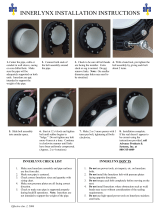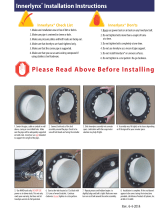
7
insulated piping system
Instructions for Laying R-flex
R-flex can easily be placed in earth-contact trenches. The corrugated jacket
provides the necessary protection for the insulating material and the PEX pipe.
Groundwater has no influence on the R-flex system. When laying the R-flex
directly into the trench, be careful not to pull the piping by the outer jacket.
Doing so may cause damage to the corrugation of the jacket. Pull R-flex by
grabbing the carrier pipes – never pull the jacket.
When uncoiling the pipe, please take care to ensure the pipe is not dragged
along the ground. Doing so can cause the R-flex to be damaged by sharp
objects. It is important to maintain control of the ends of each R-flex coil to
prevent pipe ends from whipping back when untying the textile straps. The
bending radii (see product data sheet) must not fall below the prescribed
minimum during installation or when positioning the pipeline. Pipes must be laid
in a serpentine course and may be covered with sand at regular intervals to
prevent unwanted movement. General guidelines for laying underground pipes
must be followed.
When laying larger dimensions and lengths, pulling devices such as winches or
tail-end rollers may be used. Always connect these devices to the carrier pipe.
The carrier pipe ships from the factory with fitted protective end caps to
prevent the entry of dirt and debris into the R-flex. Do not remove these caps
until ready to connect the R-flex to a fixed connection.
Since the R-flex pipe is laid in a serpentine pattern, it is necessary to design for
more pipe length than the measured trench length.
Backfilling Guidelines
Carefully place the R-ex pipeline on a compacted 4.0” (10 cm) bed of sand
on the bottom of the trench. The quality of this sand bed providing uniform
support for the pipe line has a decisive influence on the compressive stress of
the system. Make sure that the pipes are fully covered with sand
(granularity of 0-3mm).
Backfilling should be in layers of
about 8.0" (20 cm) and compacted
by hand. Care should be taken to
remove any sharp objects from the
backfill material. When the backfill has
been brought to about 20.0" (50 cm)
above the top of the pipe, a vibrating
tamper may be used to compact the
remainder of the soil. There should
also be a warning tape bearing the
legend “water pipe” laid directly above
the pipe.
Once the trenches are excavated, the
first layer of backfill should be carefully
compacted with a shovel. When the
backll has been brought to about 20" (50 cm) above the top of the pipe, a
vibrating tamper may be used to compact the remainder of the soil. Do not
use a backhoe or other mechanical device to fill the first layer of the trench as
damage to the R-flex may occur.
Transitions
When transitioning R-flex across a structural wall, be sure to keep the Dual
pipe oriented in the vertical plane, as shown. Failure to do this will cause
connection issues at necessary intersections.
The point where the R-flex penetrates the structure must be sealed. This can
be done in a variety of ways, depending on the wall construction.





















